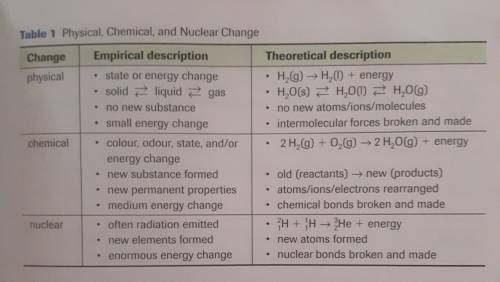
Chemistry, 13.07.2019 21:00 alyssawage
Must be answered ! how do chemical reactions differ from nuclear reactions? chemical reactions involve electrons and protons, and nuclear reactions only involve electrons. chemical reactions involve bonding between elements, and nuclear reactions involve changes to an element's nucleus. chemical reactions involve forming bonds, and nuclear reactions involve breaking bonds. chemical reactions involve bonding between protons, and nuclear reactions involve bonding between electrons.

Answers: 2
Another question on Chemistry

Chemistry, 22.06.2019 07:50
Many reactions take place in aqueous solution. when potential reactants are mixed, a reaction will occur if there is some driving force that favors the formation of products. it is often convenient to categorize reactions in terms of these driving forces: precipitate formation, in which an insoluble solid is formed, weak electrolyte formation, as in a neutralization reaction involving water, or transfer of electrons, as in a redox reaction. these reactions can be represented by full molecular equations, which contain all species in the reaction mixture, or by net ionic equations, which show only the species that actually undergo a change. the latter does not contain the spectator ions, which do not undergo a net change or do not take part in the reaction. part a when the following two solutions are mixed: k2co3(aq)+fe(no3)3(aq) the mixture contains the ions listed below. sort these species into spectator ions and ions that react. drag the appropriate items to their respective bins. view available hint(s) spectator ions ions that react part b what is the correct net ionic equation, including all coefficients, charges, and phases, for the following set of reactants? assume that the contribution of protons from h2so4 is near 100 %.ba(oh)2(aq)+h2so4(aq)→ express your answer as a chemical equation. view available hint(s) nothing provide feedback
Answers: 3

Chemistry, 22.06.2019 14:50
Given the following information: mass of proton = 1.00728 amu mass of neutron = 1.00866 amu mass of electron = 5.486 × 10^-4 amu speed of light = 2.9979 × 10^8 m/s calculate the nuclear binding energy (absolute value) of 3li^6. which has an atomic mass of 6.015126 amu. j/mol.
Answers: 2


Chemistry, 23.06.2019 05:00
1. true or false: minerals are inorganic. true false 2. inorganic means that something has never been found alive 3. halite is another name for and is a mineral with a cubic crystal pattern. table salt rock salt
Answers: 2
You know the right answer?
Must be answered ! how do chemical reactions differ from nuclear reactions? chemical reactions i...
Questions

Biology, 25.10.2020 01:00


Mathematics, 25.10.2020 01:00

Mathematics, 25.10.2020 01:00


Mathematics, 25.10.2020 01:00


Mathematics, 25.10.2020 01:00

Physics, 25.10.2020 01:00

Mathematics, 25.10.2020 01:00


Mathematics, 25.10.2020 01:00

Mathematics, 25.10.2020 01:00

Mathematics, 25.10.2020 01:00

Mathematics, 25.10.2020 01:00

English, 25.10.2020 01:00


Mathematics, 25.10.2020 01:00

English, 25.10.2020 01:00

Mathematics, 25.10.2020 01:00




